Conquer Stress and Cultivate Calm with These Mindfulness Techniques
Living and working with retinoblastoma and its far-reaching impacts can be immensely challenging for families, survivors, and professionals. Finding effective ways to manage the stress is vital for our physical and mental health. Margaret Fletcher, Mindfulness instructor at East Coast Mindfulness, and founding member of The Anticancer Lifestyle Program, shares valuable techniques to help reduce stress and promote well-being.










